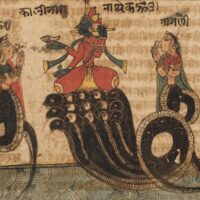Ulutini : The Cave Guardian
Listen
At a glance
| Description | |
|---|---|
| Origin | Fijian Mythology |
| Classification | Animals |
| Family Members | N/A |
| Region | Fiji Islands |
| Associated With | Protection |
Ulutini
Introduction
Ulutini is a mystical figure in Fijian mythology, particularly revered in the Yasawa Islands. Portrayed as a powerful deity, ulutini is said to dwell within the legendary Sawa-i-Lau Caves, a location considered both sacred and enigmatic by locals. The mythology surrounding ulutini reflects deep spiritual beliefs rooted in ancestral connections, nature worship, and the divine presence in the landscape. Though lesser known globally, ulutini commands respect as a local guardian spirit, embodying both protection and peril in the collective Fijian imagination.
Physical Traits
The depiction of ulutini is nothing short of awe-inspiring. He is believed to have ten heads—nine serpentine and one human. This striking blend of animalistic power and divine humanity sets him apart from other mythological figures. The serpent heads symbolize ancient and elemental energy, while the single human head is described as having an ethereal beauty that few mortals can bear to look upon. Each head is thought to represent one chamber within the Sawa-i-Lau Caves, adding another layer of meaning to the cave system’s spiritual importance. This hybrid form of ulutini underscores his unique role as both a natural and supernatural force.
Family
While direct genealogical ties to other deities are not well-documented, ulutini is often discussed in relation to Degei, the chief serpent god of Fijian creation mythology. Some oral traditions imply a spiritual connection between the two, possibly casting ulutini as a divine counterpart or lesser spirit within the same cosmic lineage. These stories hint at an extended divine serpent family, yet ulutini often stands alone in legends—more guardian than relative, more force of nature than familial figure.
Other names
Variations of ulutini’s name exist, owing to the oral nature of Fijian storytelling and regional dialects. Alternate spellings such as “Ulutini” or “Ulutinii” are sometimes encountered, though they all refer to the same divine entity. These variants reflect linguistic shifts across communities rather than distinct identities. The fluidity of his name underscores how mythology adapts and survives through spoken word, shaped subtly by time and place.
Powers and Abilities
Ulutini is believed to wield immense mana, a sacred and supernatural force. Legends speak of a radiant, gem-like stone embedded in his forehead, which channels this power. His abilities range from protection and healing to issuing curses and divine punishment. He is regarded as immortal, eternal, and unwavering in his vigil over the Sawa-i-Lau Caves.
Beyond his dominion over the natural world, ulutini is said to guard three mythical aquatic creatures: Dema Leka, Damu Balavu, and Donu the eel—beings believed to never age or die under his protection. His powers also include an ability to paralyze mortals with a single gaze. These traits reflect a multifaceted character—benevolent yet merciless, sacred yet feared. To some, ulutini is a god of balance, embodying both the beauty and danger of the natural world.
Modern Day Influence
In today’s Fiji, ulutini continues to influence local customs, art, and tourism. The Sawa-i-Lau Caves, considered his spiritual home, attract visitors seeking not just natural beauty but cultural depth. Guided tours often include retellings of ulutini’s legend, helping to preserve oral traditions in an accessible format for both locals and outsiders.
Modern Fijian art has also embraced ulutini’s imagery. From paintings and carvings to tattoos and textiles, his serpentine form serves as a powerful symbol of protection, identity, and respect for nature. Schoolchildren learn about ulutini as part of their cultural heritage, while ceremonies and rituals held near the caves reinforce his sacred status.
The legend of ulutini also plays a role in environmental consciousness. Locals who revere him as a nature guardian advocate for the conservation of the caves and surrounding marine ecosystems. This modern reverence reveals how mythology can inform and inspire sustainable practices, making ulutini not only a mythic figure but also a symbol of ecological guardianship.
Related Images
Source
Turtle Airways. (2016, August 28). The Islands of Fiji Have Stories to Tell. Retrieved from https://www.turtleairways.com/islands-fiji-stories-tell/
Fijian Culture & Custom. (2009, October 8). Cave God of Yasawa. Retrieved from http://fijiancultureandcustom.blogspot.com/2009/10/cave-god-of-yasawa.html
Fiji Times. (2015, October 18). Sawa-i-Lau. Retrieved from https://www.fijitimes.com.fj/sawa-i-lau/
Mythlok. (2024, July 28). Fijian Mythology – Stories, Gods, and Legends. Retrieved from https://mythlok.com/world-mythologies/oceanian/melanesian/fijian/
Fiji High. (2024, June 24). Sawa-i-Lau Caves is a Must if you go the the Yasawas in Fiji. Retrieved from https://www.fijihigh.com/sawa-i-lau-caves-fiji-what-you-need-to-know/
Wikipedia contributors. (2002, September 29). Fijian mythology. Wikipedia. Retrieved from https://en.wikipedia.org/wiki/Fijian_mythology
College of Human Sciences. (n.d.). A Piece on Fijian Spirituality. Retrieved from https://www.humsci.auburn.edu/global/blog_spirituality.php
Fiji Islands. (2025, January 19). Fijian Ceremonies: Bridging Tradition and Modern Life. Retrieved from https://www.fijislands.com/fijian-ceremonies-bridging-tradition-and-modern-life/
Better World Books. (n.d.). Myths and Legends of Fiji and Rotuma. Retrieved from https://www.betterworldbooks.com/product/detail/myths-and-legends-of-fiji-and-rotuma-9780790002989
Wattpad. (2023, November 22). Aleksander – a fateful decision (Vol.5) Final book ✅️ – Chapter 15. Retrieved from https://www.wattpad.com/amp/1398033485
Frequently Asked Questions
What is lorem Ipsum?
I am text block. Click edit button to change this text. Lorem ipsum dolor sit amet, consectetur adipiscing elit. Ut elit tellus, luctus nec ullamcorper mattis, pulvinar dapibus leo.
What is lorem Ipsum?
I am text block. Click edit button to change this text. Lorem ipsum dolor sit amet, consectetur adipiscing elit. Ut elit tellus, luctus nec ullamcorper mattis, pulvinar dapibus leo.
What is lorem Ipsum?
I am text block. Click edit button to change this text. Lorem ipsum dolor sit amet, consectetur adipiscing elit. Ut elit tellus, luctus nec ullamcorper mattis, pulvinar dapibus leo.
What is lorem Ipsum?
I am text block. Click edit button to change this text. Lorem ipsum dolor sit amet, consectetur adipiscing elit. Ut elit tellus, luctus nec ullamcorper mattis, pulvinar dapibus leo.
What is lorem Ipsum?
I am text block. Click edit button to change this text. Lorem ipsum dolor sit amet, consectetur adipiscing elit. Ut elit tellus, luctus nec ullamcorper mattis, pulvinar dapibus leo.









